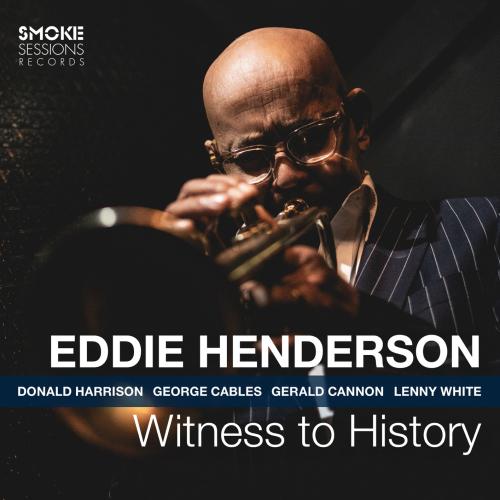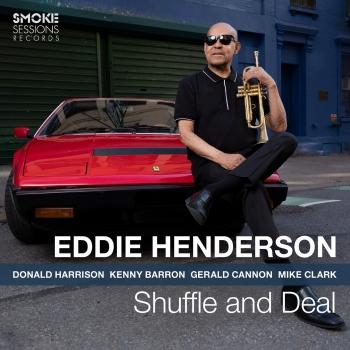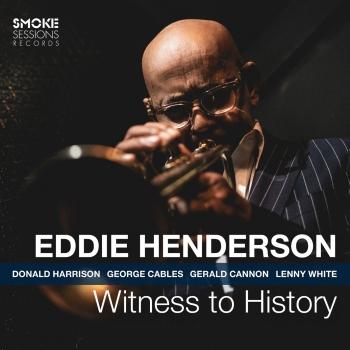
Witness to History Eddie Henderson
Album Info
Album Veröffentlichung:
2023
HRA-Veröffentlichung:
29.03.2024
Das Album enthält Albumcover
- 1 Scorpio Rising 07:01
- 2 Why Not? 08:35
- 3 Sweet and Lovely 07:40
- 4 It Never Entered My Mind 08:45
- 5 Freedom Jazz Dance 05:21
- 6 I'm Gonna Miss You, My Darling 05:02
- 7 Totem Pole 07:04
- 8 Born to Be Blue 06:27
Info zu Witness to History
Trumpet legend Dr. Eddie Henderson celebrates the 50th anniversary of his debut album with a stunning new recording, WITNESS TO HISTORY, reflecting on his musical evolution with pianist George Cables, saxophonist Donald Harrison, bassist Gerald Cannon and drummers Lenny White and Mike Clark.
If it hadn’t already been used for a 1950s television series, I LED THREE LIVES might have been an ideal title for the upcoming documentary about Eddie Henderson, who would be a fascinating subject in any one of those lives: as a medical doctor, as a pioneering figure skater, and of course as a legendary jazz musician. As it is, the film is scheduled to premiere on PBS in 2024 under the equally apt title of DR. EDDIE HENDERSON: UNCOMMON GENIUS.
If the process of making the documentary has forced Henderson to look back over the impressive scope of his own life, it’s also led him to ruminate on the broad sweep of momentous events and influential figures that he’s encountered over the course of his nearly 83 years on the planet. On his exhilarating new album WITNESS TO HISTORY, Henderson has assembled a collection of musicians and material that represent key points along that consequential timeline.
“My first trumpet teacher, way back in 1949, was Louis Armstrong,” recalls Henderson, who met the trumpet icon through his mother, a dancer at Harlem’s famed Cotton Club.
“From that point on, I witnessed the evolution in music through Miles Davis, Freddie Hubbard, Lee Morgan, Booker Little, Woody Shaw, John Coltrane, up to the present. I lived through the turmoil of the ’60s and ’70s and the rise of Black Power in this country. I was also fortunate to come into contact with people like Sugar Ray Robinson, Joe Louis, and Willie Mays. So, I have been a witness to history, and inevitably that rubbed off on me musically.”
The release of WITNESS TO HISTORY arrives on the 50th anniversary of Henderson’s debut as a leader, 1973’s REALIZATION. The stellar quintet on this album bridges that half-century of music: lifelong collaborator George Cables returns once again to the piano bench. Henderson’s colleague in The Cookers, alto saxophonist Donald Harrison, and his more recent collaborator, bassist Gerald Cannon, have also appeared on the trumpeter’s recent string of releases for Smoke Sessions. They’re joined by legendary drummer Lenny White, who has reunited with Henderson in the studio for the first time since REALIZATION 50 years ago.
Henderson’s “Scorpio Rising,” which opens the album with two drummers, also features a guest appearance by drummer Mike Clark, who, like Henderson, was an integral part of Herbie Hancock’s groundbreaking fusion groups (Henderson in Mwandishi, Clark in the Headhunters). The piece explicitly revisits “Scorpio-Libra,” the searching opening track from REALIZATION. Henderson’s airy yet piercing approach, the hip-hop influence on White’s grooves, and Clark’s exploratory interjections, all hint at the original while exemplifying the distance all have traveled in the intervening years.
The album continues with “Why Not?,” the title tune from Cables’ own 1975 leader debut, making for another fascinating career bookend. “I chose songs for this album that stood out in my mind for shaping my musical destiny,” Henderson says. “George and I are close musical affiliates, and I’ve always loved the way he writes, the way he leaves a lot of space and lets things float. I’ve played that tune with George on live gigs, and I’ve always wanted to record it, so like the title says, why not?”
While many of the remaining pieces are classic standards, four of them represent a kind of Mount Rushmore for the post-Armstrong jazz trumpet, at least in Henderson’s estimation. “Totem Pole” is the one piece actually written by one of the horn players I question, a cut from Lee Morgan’s immortal THE SIDEWINDER, here given more of a bossa nova feel. He discovered “Born to Be Blue,” meanwhile, from Freddie Hubbard, though Henderson’s version shifts from a ballad to a simmering mid-tempo swing. Finally, “Sweet and Lovely” is a nod to Booker Little, again reimagined from a melancholy ballad to a ¾ swagger.
Henderson says that “It Never Entered My Mind” really “hit a nerve” when he first heard Miles Davis’ rendition as a teenager. Eddie Harris’ “Freedom Jazz Dance” is another homage to Miles, as Henderson fell in love with Davis’ renowned version from Miles Smiles.
Finally, “I Am Going to Miss You, My Darling” is the latest contribution to Henderson’s songbook from the pen of his wife Natsuko. The gorgeous ballad is named for her sentiment whenever Henderson heads out on the road, vividly captured by the pining melody. “Natsuko is a very prolific composer with an innate, God-given musical talent,” says Henderson. “This particular tune was particularly meaningful because we are inseparable when we’re together. She usually travels with me, but it is difficult when we’re apart.”
Three lives, eight decades, more than fifty years of incredible music. WITNESS TO HISTORY traces Eddie Henderson’s evolution through a remarkable span of time but listening to this captivating album, it’s abundantly clear that he’s done more than watch from the sidelines as history unfolds. Dr. Henderson has made his own indelible mark on history, and this vital music reveals that he’s far from writing his final chapter.
Eddie Henderson, trumpet
Donald Harrison, alto saxophone
George Cables, piano & Fender Rhodes
Gerald Cannon, bass
Lenny White, drums
Mike Clark, drums (track 1)
Recorded on September 13, 2022 at Sear Sound Studio C, New York City
Recorded, Mixed & Mastered by Chris Allen
Assisted by Andrew Kochinka
Photography by Christopher Kayfield
Produced by Paul Stache & Damon Smith
Eddie Henderson
Jazz trumpeter extraordinaire Eddie Henderson received his first informal lesson on the trumpet at the age of 9 from Louis Armstrong. As a teenager he studied trumpet at the San Francisco Conservatory of Music and performed with the San Francisco Conservatory Symphony Orchestra. In 1957, Eddie met Miles Davis for the first time. Miles, a family friend, admired the strikingly beautiful tone and musicality of Henderson’s trumpet playing and encouraged him to pursue a career in music. As a family friend, Miles has been a major musical influence on Eddie throughout his life. That culminated in May of 2002 with the recording of So What, a tribute to Miles that features songs associated with the legend. As Henderson puts it, “Miles is so very special to me because when I was in high school he stayed in my parent’s house when he came through San Francisco. I was going to the conservatory then studying classical music. I saw him do all these songs live that I recorded on the tribute album.”
Eddie had the good fortune of meeting many famous musicians growing up (including getting those early tips from Satchmo) because his parents were both entertainers. His mother was a dancer at the original Cotton Club and his father a member of the popular singing group Billy Williams and the Charioteers. His stepfather was a doctor to people like Miles, Coltrane and Duke Ellington, so the association with musicians continued. In addition to excelling on his instrument, Eddie excelled academically enough to go to medical school and become a doctor.
From 1968 until the late ‘80s, Henderson mixed music and medicine. He received his first major musical exposure as a member of Herbie Hancock’s trailblazing Mwandishi sextet, an ensemble that also included young innovators such as Bennie Maupin, Julian Priester, Buster Williams and Billy Hart. From 1969 through 1973 they recorded Mwandishi and Crossings for Warner Bros. and Sextant for Columbia. His experiences with Hancock exerted a profound influence on Henderson as reflected in the music on his first two solo albums, Realization and Inside Out, recorded in 1972 and 1973 for Capricorn Records.
After leaving Hancock, the trumpeter worked extensively with Pharoah Sanders, Norman Connors and Art Blakey’s Jazz Messengers. Eddie returned to the San Francisco Bay Area in 1975 where he joined the Latin-jazz group Azteca and fronted his own bands. The expressive rhythmic thrust of Henderson’s jazz/fusion experiences manifested itself on his Blue Note recordings Sunburst and Heritage and in 1977, he broke through with a single on the Billboard charts, “Prance On” (from the album Comin’ Through).
Eddie has also performed with such notables as Dexter Gordon, Roy Haynes, Jackie McLean, Joe Henderson, Elvin Jones, Johnny Griffin, Slide Hampton, Benny Golson, Max Roach and McCoy Tyner.
Dieses Album enthält kein Booklet












